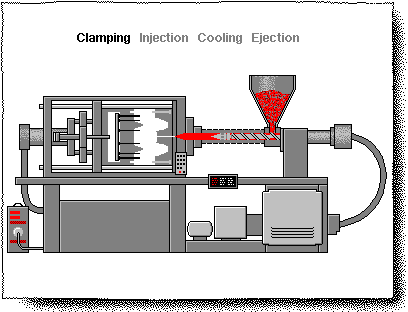
|
Ningbo Jinyi Precision Machinery Co., Ltd.
|
Gold Index: 25514
You are here: home > Study Room > Injection Molding Trouble Shooting--02
Product (264)
-
Screw Barrel
(242)
- Single Screw Barrel (137)
- Injection Screw Barrel (29)
- Extrusion Screw Barrel (13)
- Bimetallic Screw Barrel (13)
- Twin Screw Barrel (18)
- Screw Barrel Accessory (21)
- Plastics Screw Barrel (8)
- Recycling Screw Barrel (2)
- Blowing Film Screw Barrel (1)
- Tie Bar (4)
- Reduction Gearbox (4)
- Auxiliary Machinery (14)
Trade Show (15)
Equipment (13)
Certificate (5)
Develop & Customers (1)
Study Room (17)
Credit Report
Products Index
Study Room
Injection Molding Trouble Shooting--02

A sink mark is a depression in the molded product surface. This is one of the greatest causes for defects and most often occurs on thick ribs or other projecting parts. Sink marks happen when cooling resin loses some of its volume, and this shrinkage is not replenished. This volume reduction can also cause voids inside the plastic.
It is important to supply sufficiect packing pressure to fill in areas where volume has been reduced during resin cooling. Be sure that the wall thickness of the mold are uniform during the mold design stage.
Cause | Solution | ||
Injection pressure is low. | Increase injection pressure and time. | ||
Cooling time is short. | Lower the mold temperature and lengthen the cooling time. | ||
Resin shrinks excessively during cooling. | Lower the cylinder temperature. Blend in an inorganic additive to the material to reduce shrinkage. | ||
The mold temperature is high. | Lower the mold temperature. | ||
Resin volume per shot is insufficient. | Increase the resin measurement slightly. *Be careful not to induce flashing | ||
Molded products are too thick. | If the thickness occurs at the reinforced parts of the product, reduce the thickness and design ribs instead. Design the product thickness to be as uniform as possible and do not allow abrupt changes in thickness. Design the rib and boss to be as small and thin as possible. | ||
The gate, sprue or runner are small. | Increase the size so that pressure is delivered evenly throughout the mold. | ||
The gate position is improper. | Position the gate where the mold is thick. | ||
The gate is too big (when the resin flows back out of the cavity). | Reduce the gate size. Increase the packing time. | ||
Wait ! Which case would be better, lower mold temperature or higher mold temperature?
Polyethylene and polypropylene are known as crystalline polymers, which means that crystals form internally when these substances cool. The extent of this phenomenon, called degree of crystallinity, greatly depends on the cooling rate. If the mold temperature is raised, resin cooling occurs more slowly and crystallization occurs adequately many crystals are formed, increasing the density. This increases the strength of the finished product but diminishes impact strength. Conversely, by setting the mold temperature lower, you shorten the mold cycle time, but resin orientation is big, mold shrinkage is very uneven and surface gloss is adversely affected. These factors will make product quality. Short mold cycles are important, but but they should only be reduced within parameter that do not detract from product quality
6) Jetting
"Jetting" is marks on the product surface that look like a worm has crawled across it. When molds have a small cold slug well, the cool resign that comes out of the nozzle will harden first on the mold surface. Subsequent hot resin that enters the mold will not blend well with the cooler layer and will pile up, forming noticeable lines. This problem can be addressed by changing the gate position or enlarging the gate to slow the flow speed. Another method is to install a tap gate.
Cause | Solution | ||
Injection speed is fast. | Slow the injection speed down. | ||
The mold design is bad. | Enlarge the cold slug well. Increase the gate sectional area. | ||
The resin viscosity is high. | Increase the nozzle temperature. Increase the resin temperature. Increase the output of the nozzle heater. | ||
The mold temperature is low. | Raise the mold temperature. (Keep it 20 degrees below the thermal distortion temperature.) | ||
7) Silver Streaks
Silver streaks in the flow direction are caused by gases formed during molding when the pellets has not been dried sufficiently and contains too much moisture or some volatile substance. The gases run across the product surface before the resin has hardened. Silver streaks can be prevented by drying the pellets well and preventing volatility.
Cause | Solution | ||
Moisture and volatile materials in the resin vaporize. | Use the resin (pellets) after thorough drying (3-4 hours at 80-85 degrees). | ||
Foreign substances are mixed in with the pellets | Use care in handling the pellets and make sure the cylinder remains clean. Purge (the cylinder) sufficiently before use. | ||
Volatility created by thermal decomposition. | Lower the cylinder temperature and shorten the molding cycle. | ||
Air is not discharged from the mold properly. | Discharge more air. | ||
Cooling water or mold releasing agent flow into the mold and stain the surface. | Keep the mold surface clean. | ||
Injection is too fast. | Slow down injection speed. | ||
Injection pressure is too high. | Lower injection pressure. | ||
8) Flash
Molten resin flows to places outside the mold (joint, slide, insert slot, between the injector pins, etc.) and hardens. This problem occurs when the resin flows too well or when spaces are in the mold or other parts. First, lower the injection temperature to slow the resin flow and reduce the amount of resin to be loaded in the mold. Also check for irregularities in the mold and take any necessary corrective action.
Cause | Solution | ||
Mold clamping force is insufficient. | Increase the mold clamping force. Lower the injection pressure. | ||
The resin flows too well. | Lower the temperature of the resin and the mold. Lower the injection pressure and temperature. | ||
The mold does not close tightly enough. | Clean foreign substances off the mold surface. Inspect the mold balance and mold clamp setting. Inspect the mold surface finish. | ||
Too much resin fills the mold. | Check to see if the resin load amount is excessive. | ||
The mold is bent. | Provide some support for the mold. Increase the mold thickness. | ||
* If flash cannot be eliminated entirely, you may have to replace the injection molding machine!!
- Mold clamping force ¡Ã projected area x cavity internal pressure
(The internal cavity pressure is generally 200-400 kg/cm2, and the projected area includes the runner.)
* If the injection molding machine's clamping force is greater than the pressure on the mold projected area,
as calculated with the above formula, then the machine must be replaced with one with a higher capacity .
Pre Page:
Injection Molding Trouble Shooting--01
Next Page:
Injection Molding Trouble Shooting--03



